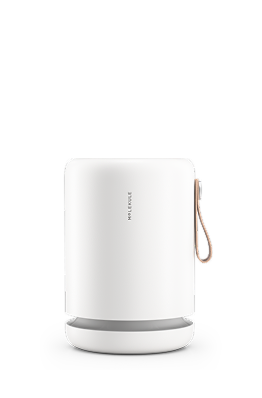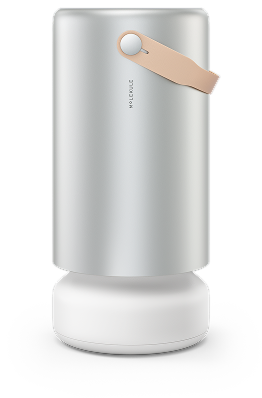We have already talked about how to turn your home into a sanctuary in our previous post with Bobby Berk. This time we want to talk about a few ways to make simple but impactful changes in your home.
Color and light are very important to consider during home improvements, but this time we want to plan even more specific methods of making your home feel just right. A home must first make you feel healthy, so before you even place a pillow, have a plan to keep things clean and do not forget the air. Larger projects that involve renovation obviously add unhealthy particles and chemicals into the air, but smaller changes should be considered too. Then we can consider accent colors, how to paint walls differently in the same room, and what a rug is used for.

1. Old dust and new chemicals impact air quality
Used items can harbor dust and new items may release gaseous pollutants over time. You can open a window to dilute contaminants, but using a portable air purifier like one of Molekule’s is an easy way to remove the pollutants that are in your breathing zone.
Out with the old
- Dust that has accumulated under furniture, in low-traffic areas, and in other hard-to-reach places is almost always stirred up during any home improvements. Dust is spectacularly unhealthy, there is a reason your body expels it with sneezes. The tiny particles can harbor flame retardants, dust mites, insect allergens, pollen fragments, volatile organic compounds, mold spores, bacteria, and many other pollutants. This is particularly true with used rugs or furniture.
- So clean any used rugs you get and vacuum upholstery deeply. All rugs and most furniture can harbor years of accumulated dust, fungus, and insect activity.
Out with the new, too
- Off-gas from new products can also have a negative impact on air quality, so take care when adding new materials to your home. Even if you are just painting the floorboards, fumes and chemical gases can impact your air quality. New rugs or furniture can be made with lacquers, adhesives, or plastic composites that may be releasing harmful gases into your home.
- If you can smell the off-gas then there is likely enough to impact air quality, so leave smelly new items in an unoccupied area if possible and try to avoid breathing fumes if they accumulate.
If the weather is not appropriate for frequent ventilation or you want cleaner air in general, we recommend a portable air purifier that can capture dust but can also destroy chemicals and allergens. Molekule’s PECO technology can capture and destroy all the pollutants we have mentioned using advanced proprietary technology inside the purifier. Then the soft neutral lines of the purifier’s outside will not draw undue attention from your chosen decor.
2. Add a layer with an accent color
Vision is our dominant sense, but 80% of our visual information comes from memory, not our eyes. That’s why home is more than a specific color or shape. Environmental psychologists describe how the experience of those colors and shapes should be simple enough to understand but complex enough to be interesting.
Accent colors are splashes of color that can help to make the simple more complex or the complex more simple, depending on how they are used. They are generally lighter, darker, or contrasting compared to the main color palette of a room. Almost anything can have an accent color, but here are some of the more popular choices.
- Accent baseboards, molding, or exposed beams to create more defined outlines. Outlining a room or feature tends to add a layer to a room, so if it is already busy choose carefully. On the other hand, outlining rough textures like wood or stone can make them simpler and more defined.
- Painting window frames or door frames can draw attention to what’s happening beyond. Deeper blues can work well with windows that frame the sky, while dark browns and dark greens might go well with trees outside.
- Throws, pillows, or other fabrics can provide a lighter or dark color when the features of a room are too closely color matched to provide contrast.
- Hanging pictures and posters with bold frames is another way to add accents. Wooden frames look nice pretty much everywhere, while solid color frames are best in black for light walls and white for dark walls.
- Bobby likes to suggest painting one wall an accent color. Wallpaper or other floor-to-ceiling features are other choices for an accent wall and as we said in the previous section you can modify the impact if the other walls and ceiling are lighter or darker. A darker accent wall will be closer and cozier, while a lighter accent wall will be more distant and dramatic.

A special word on black, which is possibly the most effective accent color. With light walls it can lend a Victorian feel to kitchens and bathrooms. In a room with a lot of matching colors, small dots of black such as pillows or other accessories can add texture against light colored walls and furniture by providing high-contrast dots to break up the scene.
With dark or wooden floors, a black baseboard adds a layer by outlining the shape of the room. A room with lighter-colored walls and black molding can feel more enclosed without having to feel darker.
3. Shape the space with walls of a different color
Another study on the psychology of interior design describes how important the perception of boundaries is to feel comfortable at home, depending on what you are doing. A contained feeling that is private, quiet, and safe is equally important to an open feeling that lets in guests or views of the outside.
Dark and light colored walls can change the perception of a room’s boundaries, which will change the feel of its size. As a general rule, darker and warmer colored walls will seem closer while cooler and lighter colored walls will seem more distant. Both can have benefits and drawbacks depending on how you want the room to make you feel, and painting walls different colors creates a more complex interaction.
- Light colored or bluish walls remind us of the sky, open air, and distant horizons.
Benefit: Perception of a larger and more open space where we work and play
Drawback: Can seem cold or vulnerable
- Dark colored or reddish walls remind us of trees, enclosed spaces, and warmth.
Benefit: Perception of a warmer, cozier, and more protected space where we rest and socialize
Drawback: Can seem stuffy or cramped
When a room may seem too impersonal to invite socializing, painting just one wall a darker color, (optionally along with the ceiling) can make it seem closer and more intimate. Painting the whole room a dark color will absorb natural light and make for more private feeling space.
If the room feels too large, painting the ceiling darker will make it seem lower, which can add that sense of social intimacy. When the ceiling is already low, painting it lighter than the walls will add a perception of comfortable headroom.

4. Change the boundaries with a rug
We have talked a lot about the walls and the ceiling, but you also have a floor. When a rug properly frames furniture or a room, it can make space feel more intimate without feeling more confined.
Bobby has some great diagrams on his blog that show how to place rugs in the living room, dining room, and bedroom. The rug should be making an illusion of an enclosed space within the room. Be sure there are no gaps or paths that spoil the illusion and the space will seem bigger.
A rug should surround a dining table completely, because people will be entering from all sides. When placing chairs or a couch on a rug, the front feet should always be on the rug so there’s no gap between the rug and the resting spots. Same thing with a bed, the rug should go under the bed at least as far as the pillow, so the sleeper does not have to cross the boundary before getting in.
As far as patterns go, Bobby usually says that simpler is better. You can always add layers or more texture with accents later. However, if the room already lacks much texture a vibrant pattern can make the room warmer and more engaging.
5. Have a plan for home improvements
When planning your home improvements, choose your favorite principles and keep them in mind. Above, we mentioned the importance of balancing engagingly complex with simply minimal. We also pointed out the importance of designing with family, friends, and other company in mind. Here are a few final summary pointers to make your home look and feel like a home.
Appearance
- Layers and textures make a space more complex, stimulating, and thought provoking. If a room is too complex, add outlines or storage to remove some of the textures.
- Design each room for its specific use, so it fits seamlessly in your day and what you do.
- Draw attention to mystery and fun by outlining a feature like a window or accent wall in a color that stands out from the rest of the room.
Feeling
- To make a home feel private, safe, and well-defined as yours, each room should provide just the right level of enclosure or openness for its use.
- Using the right color combinations on different walls and accent colors can impact the perception of boundaries.
- A home is not a home without consideration of the people you will be sharing it with, so any design should have plans for guests as well.
Keep an eye on this blog and Facebook, Instagram, and Twitter accounts for more about the science of air quality and wellbeing.







